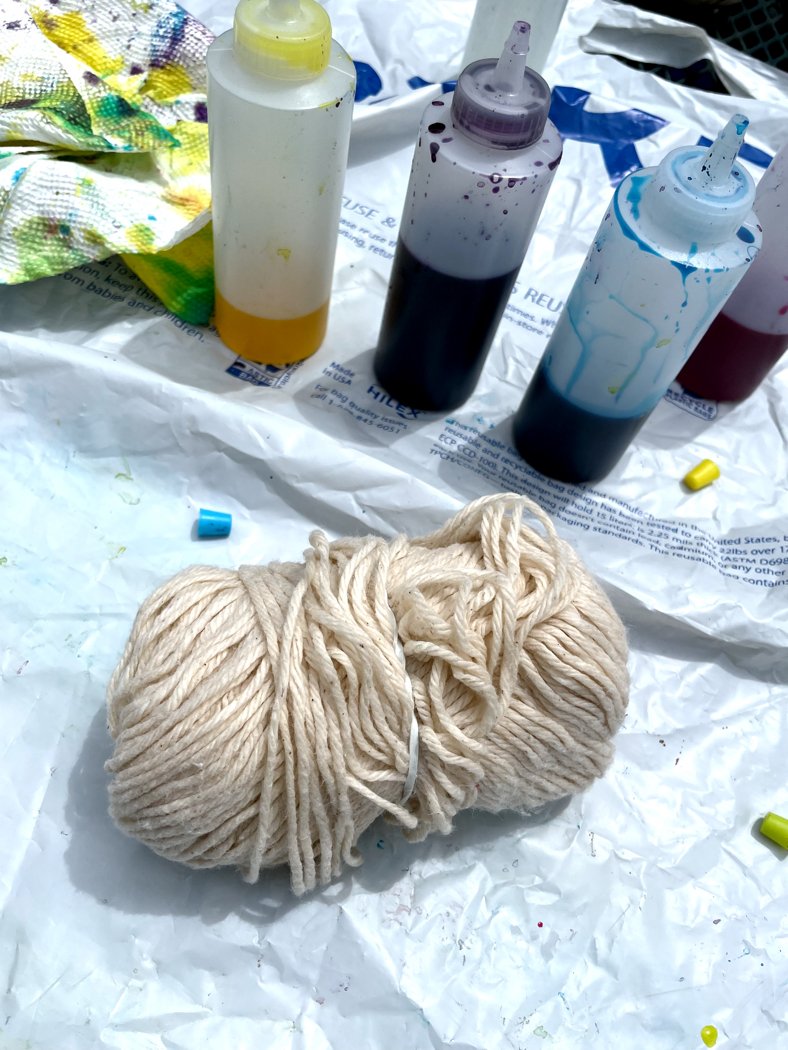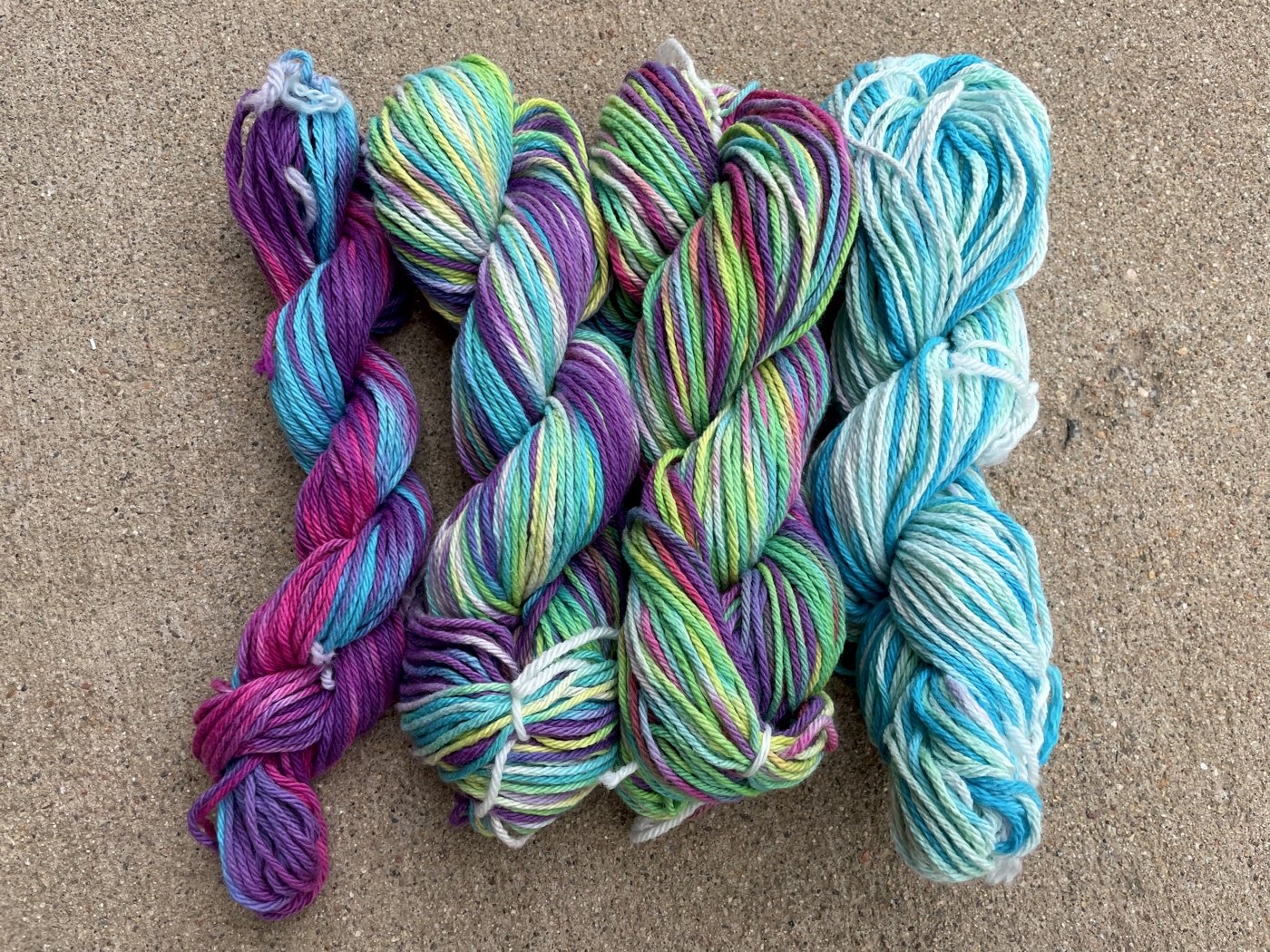Adventures In Tie-Dyeing Yarn
/I’ve been slowly scribbling out a Summer Bucket List for the past few weeks. There’s a few of the usual things - making popsicles, going to the pool, having a picnic at the park - and tackling some tie-dye. The kiddo was all in when I suggested the idea, and helped pick out a few things cover in bright neons. There were bags, shirts, a dress, and yarn of course. I dug through the stash and pulled two balls of dishcloth cotton and the last few grams of cotton from a giant cone. Spoiler alert: I could have pulled out an extra ball or two.
I kept the yarn prep pretty minimal. I skeined the yarn from the cone and kept the balls as they were. My only attempt to keep the balls from tangling was to put a rubber band around the middle. Then everything got a soak in some warm water and Eucalan to wash off the leftover oils from the spinning process. That soak probably lasted about 45 minutes because I got distracted. So all the yarn was good and damp when I got to work on it.
Next came the fun part: dyeing! I used a Tulip One Step Tie-Dye Kit in Ultimate. I saved the yarn for last so I could use up any leftover dye.
I swirled up the skein into a loose spiral before drizzling the dye over the top. Pink in the middle with purple and blue on opposite sides. Coiling it up ended up creating a lot of short sections of color which will look super cool in a washcloth.
The other two balls I drenched in dye. One half of a ball got a big chunk of color while the other half got smaller sections of different colors. I tried to get as much dye as I could in the center of the balls. Probably over did it with one because dye started pouring out when I picked up the ball. At least it was a pretty color. When I was done, each bundle of yarn went into its own bag.
There was still a little bit of dye left, but I was out of yarn. I made a second trip to the stash a day or two later and prepped one more ball of cotton the same as the others. This ball did not get as thoroughly saturated with dye as the other balls, and I’m really curious to see how it turns out.
After the dye sat for about 24 hours - way more than the recommended 8 - I rinsed out as much of the excess dye as I could under cold water. The water was still running purple, blue, pink, and green after rinsing and and lots of squishing. So they got two baths with Eucualan. The first cold and the second hot.
The water in this first cold bath was purple. And the bottom ball of yarn was just barely holding together. The second bath, and the third, were blue. Washing the third ball did exactly the same thing. In all the videos I watched about tie-dyeing yarn, no one mentioned how long or how hard it would be to rinse out the excess dye, especially when working with a yarn cake/ball. The general advice was rinse and skein the yarn to dry. That’s it. So, I had to experiment a bit to find something that worked.
Step 1: Drying the yarn. I so did not want to put a bunch of wet, dye-bleeding yarn on my swift. Thankfully, there was another option. I have a rack for the inside of my dryer that lets me dry stuff flat without tumbling it around. So, the yarn, even balls that were falling apart, went on the rack in the dryer. They didn’t get perfectly dry, but dry enough to not stain my wood swift when I wound them into skeins.
Step 2: Winding skeins. The only bit of yarn I dyed in a skein, was the only bit of yarn that wasn’t constantly bleeding more dye after multiple rinses. So, all the balls of yarn are getting turned into skeins of yarn.
This was my first chance to see how the inside of the yarn balls took up the dye! The outer most strands are on top with the inner strands on the bottom. As expected, the yarn from the outside of the ball has a deeper, more saturated color. The inner strands are more pastel, and remind me of a tie-dyed Easter egg. I’m not sure if this difference is because less dye reached the center or because the pre-soak wasn’t able to wash out as much of the spinning oils. Maybe a little of both? This gradient effect occurred across all three of the balls I dyed, no matter how much dye I used.
Step 3: One more rinse with the right soap. When I realized that just rinsing it with my usual soap wasn’t going to cut it, I ordered a bottle of Synthrapol, a special soap that catches any excess dye from yarn/fabric and suspends it in the rinse water.
By the time I got to washing and rinsing the yarn with Synthrapol a week later, I was wondering if I was being a little too cautious. Maybe the regular soap had washed the dye out already. Turns out, the extra steps were totally necessary. This is what the water looked like after soaking the yarn for 40 minutes in hot water.
This time, the water ran clear during a rinse with cold water.
Step 4: Hang it up to dry. Since I wasn’t worried about the yarn staining everything around it blue and purple, it went on drying rack. I rolled the yarn up in a towel and stomped on it a few times to squish out as much water was possible first, but that was all the special treatment it got this time around.
The finished yarn looks like it’ll be fun to work with. The colors aren’t as eye-searingly bright and saturated as they looked before washing and rinsing which I’m actually really happy with. The muted (by comparison) tones are much more my jam. I’m also curious to see how well the color holds up after multiple trips through the wash.
Now that there are 4 finished skeins in front of me, would I use a tie-dye kit to dye yarn again? Yeah. I even have a second kit in a darker color palette when I’m ready to give it a go.
Will I dye yarn again in balls? Probably not. The yarn dyed as a skein was way easier to wash and finish than the yarn balls. The skeined yarn also had a more consistent color. I had hoped for a more even color through the whole ball - just with more blank spots in the middle - which was not what happened. The ombré effect is cool, sure, but not enough of a reason for me to go through the extra steps and hassle.
The other thing I would do differently next time is prep more yarn, even if there were a few skeins that didn’t get dyed. The yarn dyed with fresh dye has a deeper color than the yarn I dyed two days later at the end of the dyes’ life span. I’d also wash the yarn with Synthrapol from the first rinse and save a lot of time and water.
Dyeing yarn with a tie-dye kit was a fun experiment. It’s been a long time since I’ve dyed yarn, and it was nice to scratch that itch after so many years. Now I’m excited to knit all this up and make some cool new kitchen towels and washcloths.
This post contains an affiliate link which means, if you decide to buy through that link, I’ll get a small commission. Thanks!












